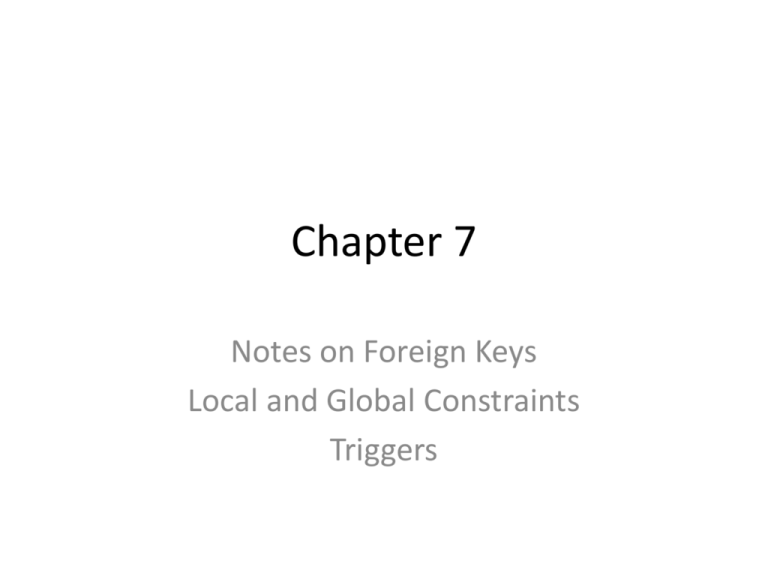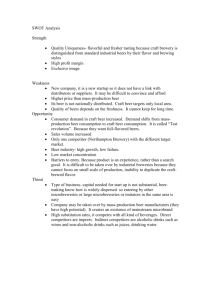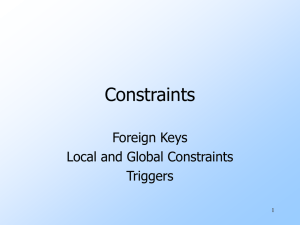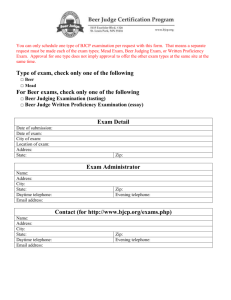Chapter 7 slides
advertisement

Chapter 7 Notes on Foreign Keys Local and Global Constraints Triggers Beginning of Chapter 7 • In this chapter we shall cover those aspects of SQL that let us create “active” elements. • An active element is an expression or statement that we write once and store in the database, expecting the element to execute at appropriate times • The time of action might be when a certain event occurs, – Such as an insertion into a particular relation, or – it might be whenever the database changes so that a certain boolean-valued condition becomes true Constraints and Triggers • A constraint is a relationship among data elements that the DBMS is required to enforce. – Example: key constraints. • Triggers are only executed when a specified condition occurs, e.g., insertion of a tuple. – Easier to implement than complex constraints. Kinds of Constraints • Keys. • Foreign-key, or referential-integrity • Value-based constraints – Constrain values of a particular attribute • Tuple-based constraints – Relationship among components • Assertions: any SQL boolean expression Single-Attribute Keys • Place PRIMARY KEY or UNIQUE after the type in the declaration of the attribute. • Example: CREATE TABLE Beers ( name CHAR(20) UNIQUE, manf CHAR(20) ); Multiattribute Key • The bar and beer together are the key for Sells: CREATE TABLE Sells ( bar CHAR(20), beer VARCHAR(20), priceREAL, PRIMARY KEY (bar, beer) ); Foreign Keys • Values appearing in attributes of one relation must appear together in certain attributes of another relation. • Example: in Sells(bar, beer, price), we might expect that a beer value also appears in Beers.name . Expressing Foreign Keys • Use keyword REFERENCES, either: 1. After an attribute (for one-attribute keys). 2. As an element of the schema: FOREIGN KEY (<list of attributes>) REFERENCES <relation> (<attributes>) • Referenced attributes must be declared PRIMARY KEY or UNIQUE. Example of Using REFERENCES After an Attribute CREATE TABLE Beers ( name CHAR(20) PRIMARY KEY, manf CHAR(20) ); CREATE TABLE Sells ( bar CHAR(20), beer CHAR(20) REFERENCES Beers(name), price REAL ); Example of using References as an Element of the Schema CREATE TABLE Beers ( name CHAR(20) PRIMARY KEY, manf CHAR(20) ); CREATE TABLE Sells ( bar CHAR(20), beer CHAR(20), price REAL, FOREIGN KEY(beer) REFERENCES Beers(name)); Enforcing Foreign-key Constraints • If there is a foreign-key constraint from relation R to relation S, two violations are possible: 1. An insert or update to R introduces values not found in S. 2. A deletion or update to S causes some tuples of R to “dangle.” Actions Taken – Part 1 • Example: suppose R = Sells, S = Beers. • An insert or update to Sells that introduces a nonexistent beer must be rejected. • A deletion or update to Beers that removes a beer value found in some tuples of Sells can be handled in three ways (next slide). Actions Taken – Part 2 1. Default : Reject the modification. 2. Cascade : Make the same changes in Sells. – – Deleted beer: delete Sells tuple. Updated beer: change value in Sells. 3. Set NULL : Change the beer to NULL. Example of the Cascade Action • Delete the Bud tuple from Beers: – Then delete all tuples from Sells that have beer = ’Bud’. • Update the Bud tuple by changing ’Bud’ to ’Budweiser’: – Then change all Sells tuples with beer = ’Bud’ to beer = ’Budweiser’. Example of the SET NULL action • Delete the Bud tuple from Beers: – Change all tuples of Sells that have beer = ’Bud’ to have beer = NULL. • Update the Bud tuple by changing ’Bud’ to ’Budweiser’: – Same change as for deletion. Choosing a Policy • When we declare a foreign key, we may choose policies SET NULL or CASCADE independently for deletions and updates. • Follow the foreign-key declaration by: ON [UPDATE, DELETE][SET NULL CASCADE] • Two such clauses may be used. • Otherwise, the default (reject) is used. Example of Setting the Policy CREATE TABLE Sells ( bar CHAR(20), beer CHAR(20), price REAL, FOREIGN KEY(beer) REFERENCES Beers(name) ON DELETE SET NULL ON UPDATE CASCADE ); 7.2 Constraints on Attributes and Tuples • Within a SQL CREATE TABLE statement, we can declare two kinds of constaints – A constraint on a single attribute – A constraint on a tuple as a whole • A simple constraint is to associate with an attribute is NOT NULL Attribute-Based Checks • Constraints on the value of a particular attribute. • Add CHECK(<condition>) to the declaration for the attribute. • The condition may use the name of the attribute, but any other relation or attribute name must be in a subquery. Example of an Attribute-Based Check CREATE TABLE Sells ( barCHAR(20), beer CHAR(20) CHECK ( beer IN (SELECT name FROM Beers)), price REAL CHECK ( price <= 5.00 ) ); Timing of Checks • Attribute-based checks are performed only when a value for that attribute is inserted or updated. – Example: CHECK (price <= 5.00) checks every new price and rejects the modification (for that tuple) if the price is more than $5. – Example: CHECK (beer IN (SELECT name FROM Beers)) not checked if a beer is deleted from Beers (unlike foreign-keys). Tuple-Based Checks • CHECK (<condition>) may be added as a relation-schema element. • The condition may refer to any attribute of the relation. – But other attributes or relations require a subquery. • Checked on insert or update only. Example of a Tuple-Based Check • Only Joe’s Bar can sell beer for more than $5: CREATE TABLE Sells ( bar CHAR(20), beer CHAR(20), priceREAL, CHECK (bar = ’Joe’’s Bar’ OR price <= 5.00) ); 7.3 Modification of Constraints • It is possible to add, modify, or delete constraints at any time • In order to modify or delete a constraint, it is necessary to give a constraint a name ALTER TABLE MovieStar DROP CONSTRAINT NameIsKey; 7.4 Assertions • These are database-schema elements, like relations or views. • Defined by: CREATE ASSERTION <name> CHECK (<condition>); • Condition may refer to any relation or attribute in the database schema. Example of an Assertion • In Sells(bar, beer, price), no bar may charge an average of more than $5. CREATE ASSERTION NoRipoffBars CHECK ( NOT EXISTS ( SELECT bar FROM Sells Bars with an GROUP BY bar average price above $5 HAVING 5.00 < AVG(price) )); Example of an Assertion • In Drinkers(name, addr, phone) and Bars(name, addr, license), there cannot be more bars than drinkers. CREATE ASSERTION FewBar CHECK ( (SELECT COUNT(*) FROM Bars) <= (SELECT COUNT(*) FROM Drinkers) ); Timing of Assertion Checks • In principle, we must check every assertion after every modification to any relation of the database. • A clever system can observe that only certain changes could cause a given assertion to be violated. – For example, no change to Beers can affect FewBar. Neither can an insertion to Drinkers. 7.5 Triggers • Assertions are powerful, but the DBMS often can’t tell when they need to be checked. • Attribute- and tuple-based checks are checked at known times, but are not powerful. • Triggers let the user decide when to check for any condition. Event-Condition-Action Rules • Another name for “trigger” is ECA rule, or eventcondition-action rule. • Event : typically a type of database modification, e.g., “insert on Sells.” • Condition : Any SQL boolean-valued expression. • Action : Any SQL statements. Preliminary Example of a Trigger • Instead of using a foreign-key constraint and rejecting insertions into Sells(bar, beer, price) with unknown beers, a trigger can add that beer to Beers, with a NULL manufacturer. Example of a Trigger Definition The event CREATE TRIGGER BeerTrig AFTER INSERT ON Sells REFERENCING NEW ROW AS NewTuple FOR EACH ROW The condition WHEN (NewTuple.beer NOT IN (SELECT name FROM Beers)) INSERT INTO Beers(name) The action VALUES(NewTuple.beer); Options for CREATE TRIGGER • CREATE TRIGGER <name> • Or: CREATE OR REPLACE TRIGGER <name> – Useful if there is a trigger with that name and you want to modify the trigger. Options for When the Trigger is Run • AFTER can be BEFORE. – Also, INSTEAD OF, if the relation is a view. • A clever way to execute view modifications: have triggers translate them to appropriate modifications on the base tables. • INSERT can be DELETE or UPDATE. – And UPDATE can be UPDATE . . . ON a particular attribute. The FOR EACH ROW Option • Triggers are either “row-level” or “statement-level.” • FOR EACH ROW indicates row-level; its absence indicates statement-level. • Row level triggers : execute once for each modified tuple. • Statement-level triggers : execute once for a SQL statement, regardless of how many tuples are modified. Options for REFERNCING • INSERT statements imply a new tuple (for row-level) or new table (for statement-level). – The “table” is the set of inserted tuples. • DELETE implies an old tuple or table. • UPDATE implies both. • Refer to these by [NEW OLD][TUPLE TABLE] AS <name> Options for The Condition • Any boolean-valued condition. • Evaluated on the database as it would exist before or after the triggering event, depending on whether BEFORE or AFTER is used. – But always before the changes take effect. • Access the new/old tuple/table through the names in the REFERENCING clause. Options for The Action • There can be more than one SQL statement in the action. – Surround by BEGIN . . . END if there is more than one. • But queries make no sense in an action, so we are really limited to modifications. Another Trigger Example • Using Sells(bar, beer, price) and a unary relation RipoffBars(bar), maintain a list of bars that raise the price of any beer by more than $1. The Trigger The event – only changes to prices CREATE TRIGGER PriceTrig AFTER UPDATE OF price ON Sells REFERENCING Updates let us Condition: talk about old OLD ROW AS ooo a raise in and new tuples price > $1 NEW ROW AS nnn We need to consider each price change FOR EACH ROW WHEN(nnn.price > ooo.price + 1.00) When the price change INSERT INTO RipoffBars is great enough, add VALUES(nnn.bar); the bar to RipoffBars 40








